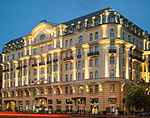Warsaw Uprising

The Warsaw Uprising (Polish: powstanie warszawskie; German: Warschauer Aufstand) was a major World War II operation by the Polish underground resistance to liberate Warsaw from German occupation. It occurred in the summer of 1944, and it was led by the Polish resistance Home Army (Polish: Armia Krajowa). The uprising was timed to coincide with the retreat of the German forces from Poland ahead of the Soviet advance. While approaching the eastern suburbs of the city, the Red Army temporarily halted combat operations, enabling the Germans to regroup and defeat the Polish resistance and to destroy the city in retaliation. The Uprising was fought for 63 days with little outside support. It was the single largest military effort taken by any European resistance movement during World War II.The Uprising began on 1 August 1944 as part of a nationwide Operation Tempest, launched at the time of the Soviet Lublin–Brest Offensive. The main Polish objectives were to drive the Germans out of Warsaw while helping the Allies defeat Germany. An additional, political goal of the Polish Underground State was to liberate Poland's capital and assert Polish sovereignty before the Soviet-backed Polish Committee of National Liberation could assume control. Other immediate causes included a threat of mass German round-ups of able-bodied Poles for "evacuation"; calls by Radio Moscow's Polish Service for uprising; and an emotional Polish desire for justice and revenge against the enemy after five years of German occupation.Initially, the Poles established control over most of central Warsaw, but the Soviets ignored Polish attempts to make radio contact with them and did not advance beyond the city limits. Intense street fighting between the Germans and Poles continued. By 14 September, the eastern bank of the Vistula River opposite the Polish resistance positions was taken over by the Polish troops fighting under the Soviet command; 1,200 men made it across the river, but they were not reinforced by the Red Army. This, and the lack of air support from the Soviet air base five-minutes flying time away, led to allegations that Joseph Stalin tactically halted his forces to let the operation fail and allow the Polish resistance to be crushed. Arthur Koestler called the Soviet attitude "one of the major infamies of this war which will rank for the future historian on the same ethical level with Lidice." On the other hand, David Glantz argued that the uprising started too early and the Red Army could not realistically have aided it, regardless of Soviet intentions.Winston Churchill pleaded with Stalin and Franklin D. Roosevelt to help Britain's Polish allies, to no avail. Then, without Soviet air clearance, Churchill sent over 200 low-level supply drops by the Royal Air Force, the South African Air Force, and the Polish Air Force under British High Command, in an operation known as the Warsaw Airlift. Later, after gaining Soviet air clearance, the U.S. Army Air Force sent one high-level mass airdrop as part of Operation Frantic, although 80% of these supplies landed in German-controlled territory.Although the exact number of casualties is unknown, it is estimated that about 16,000 members of the Polish resistance were killed and about 6,000 badly wounded. In addition, between 150,000 and 200,000 Polish civilians died, mostly from mass executions. Jews being harboured by Poles were exposed by German house-to-house clearances and mass evictions of entire neighbourhoods. German casualties totalled over 2,000 to 17,000 soldiers killed and missing. During the urban combat, approximately 25% of Warsaw's buildings were destroyed. Following the surrender of Polish forces, German troops systematically levelled another 35% of the city block by block. Together with earlier damage suffered in the 1939 invasion of Poland and the Warsaw Ghetto Uprising in 1943, over 85% of the city was destroyed by January 1945 when the course of the events in the Eastern Front forced the Germans to abandon the city.
Excerpt from the Wikipedia article Warsaw Uprising (License: CC BY-SA 3.0, Authors, Images).Warsaw Uprising
Patelnia, Warsaw Śródmieście (Warsaw)
Geographical coordinates (GPS) Address Nearby Places Show on map
Geographical coordinates (GPS)
| Latitude | Longitude |
|---|---|
| N 52.23 ° | E 21.010833333333 ° |
Address
Metro Centrum
Patelnia
00-692 Warsaw, Śródmieście (Warsaw)
Masovian Voivodeship, Poland
Open on Google Maps










